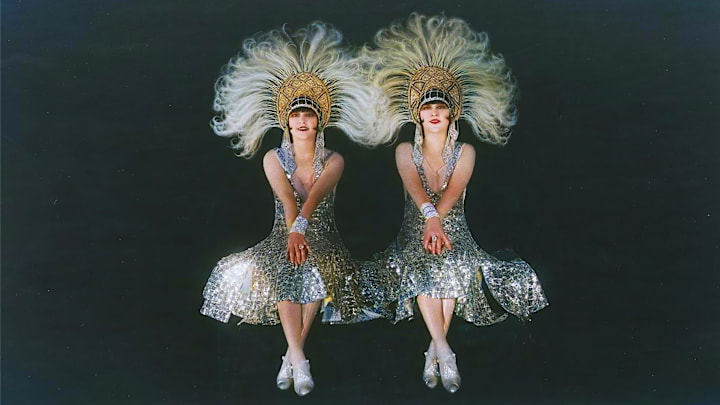In honor of Taylor Swift’s latest studio album, The Life of a Showgirl, we’re highlighting a handful of history’s most iconic showgirls—from Mistinguett of the Moulin Rouge to “Queen of Las Vegas” Lola Falana and beyond. Find out how they wowed the world below.
Mistinguett

Jeanne-marie Bourgeois—better known by her stage name, Mistinguett—was born outside Paris in 1875. She became one of France’s most famous sensations of the early 20th century, with comedic and musical routines that enthralled audiences at the Moulin Rouge, Folies-Bergère, and Casino de Paris. Mistinguett’s legs got tons of attention: The press often mentioned that she had insured them for an exorbitant amount of money, though the exact sum varied from source to source. In 1936, she herself said they were insured for $500,000—each. (That’s about $23 million total in today’s dollars.)
American musical theater fans might be a little more familiar with Mistinguett’s work than they think. The song “My Man,” popularized by American comedian Fanny Brice—and by Barbra Streisand playing Brice in 1968’s Funny Girl—is the English version of Mistinguett’s “Mon Homme.”
The Dolly Sisters

Identical twins Janszieka and Roszika Deutsch were born in Budapest, Hungary, in 1892, and immigrated to New York City with their family. They performed together as Jennie and Rosie Dolly—a.k.a. the Dolly Sisters, arguably the best-known sister act of the early 20th century. The pair started in vaudeville and appeared in a number of Broadway productions throughout the 1910s and ’20s, including 1911’s Ziegfeld Follies. European audiences adored them, too.
The sisters did sometimes perform apart, Jennie with her first husband, vaudevillian Harry Fox (the probably apocryphal namesake of the foxtrot). But they’re mostly remembered as a double act. Their lives inspired the 1945 movie musical The Dolly Sisters, starring Betty Grable as Jennie and June Haver as Rosie. Unsurprisingly, it doesn’t tell the whole story. In real life, their careers petered out by the late 1920s; Jennie was then injured in a horrible car accident in 1933 and died by suicide in 1941. Rosie died of a heart attack at age 77. The sisters are buried together with their younger brother in a mausoleum in California.
Josephine Baker

Josephine Baker, born in Missouri in 1906, brought the Jazz Age to France in a big way; her most iconic number was a dance performed in strings of pearls and a skirt made of bananas. Baker’s life offstage was just as dynamic as her showgirl acts. During World War II, she used her star power to spy for the Allies by smuggling intel written in invisible ink on sheet music—she even pinned notes to her undergarments. Later, Baker adopted 12 children, whom she called her “rainbow tribe.” She was also active in the American civil rights movement, participating in the 1963 March on Washington. She even had a pet cheetah named Chiquita.
Baker passed away in 1975. In 2021, she was reinterred in Paris’s Panthéon—making her the first Black woman (and only the sixth woman) to be buried there.
You Might Also Like ...
- 5 Fascinating Facts About Josephine Baker
- 130 Amazing Women Who Changed the World
- 7 Historical Figures You Probably Didn’t Know Were Spies
Add Mental Floss as a preferred news source!
Lola Falana

Lola Falana was born in New Jersey in 1942. As a teenager in the 1950s, she booked her first notable gig as a dancer for jazz singer Dinah Washington. Her big break came in 1964—a supporting role in the Broadway musical Golden Boy, starring Sammy Davis Jr. Falana then became famous in Italy for her TV appearances and a few film roles. But the pinnacle of her career happened back in her home country: In the 1970s and ’80s, Falana was known as the Queen of Las Vegas for her dazzling shows at top hotels.
She was one of the city’s highest-paid performers of the era; during her peak, she earned $3 million for performing at the Aladdin for 20 weeks of the year. Falana was diagnosed with multiple sclerosis in the late 1980s and withdrew from entertainment to focus on Christian missionary work.
Dolores

British fashion designer (and Titanic survivor) Lucile, a.k.a. Lady Duff Gordon, plucked Kathleen Marie Rose from obscurity as an errand girl in London and turned her into a famous model named “Dolores.” When Paris’s fashion industry foundered during World War I, Lucile took Dolores and some other models to New York to bolster the business there. Florenz Ziegfeld attended one fashion show and asked Lucile to use some of her designs—and some of her models—for his revues. “It is going to be the biggest draw I have staged in years,” he said, according to Lucile’s 1932 memoir. “That girl Dolores is marvellous, she will be the sensation of New York.”
Ziegfeld was right about Dolores: The 6-foot-tall blonde goddess captivated audiences and would influence runway culture for decades to come. Legendary fashion editor Diana Vreeland remembered Dolores as “the greatest” of Ziegfeld’s showgirls. “She was very highly paid just to walk across the stage—and the whole place would go to pieces,” Vreeland said in her 1980 book Allure. “It was a good walk I can tell you—it had such fluidity and grace. Everything I know about walking comes from watching Ziegfeld’s girls.”

Dolores, for her part, felt her appeal was one-dimensional and fleeting. “I recognize perfectly that the show girl end of the stage has no future to it. We haven’t histrionic ability and we don’t delude ourselves about any visionary career,” she said in a 1920 interview. “I’m here because I have looks, and I won’t have enough looks after thirty to be here.” Her plan was to marry well and leave the scene before she got phased out. In 1923, she wed American millionaire William Tudor Wilkinson in Paris and retired there.
